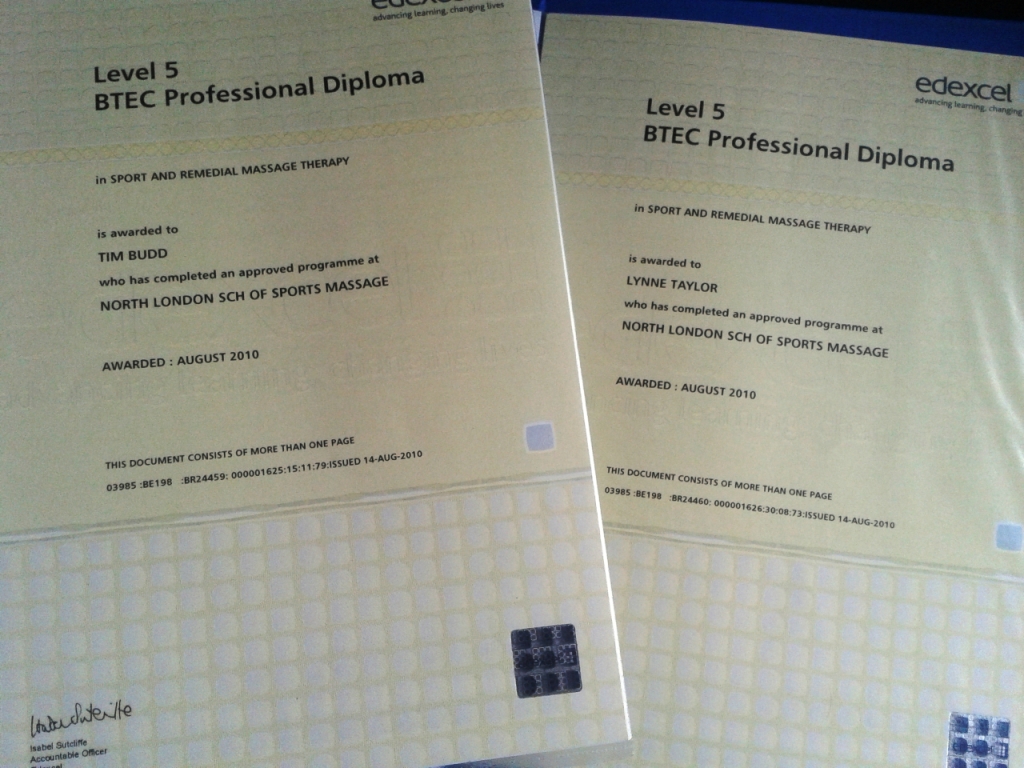There are a decent number of people out there with sports massage qualifications now. Or at least, a good number of people out there who are advertising sports massage as a service, though there are a confusing array of different qualifications that allow them to advertise themselves as such.
The main qualifications out there are under the BTEC banner. They start off at Level 3 and go to Level 5, but what is the difference, and what can you expect from a practitioner of each level?
BTEC Level 3
A one-weekend qualification, generally done as a continual professional development course for a Personal Trainer or as a foundation course before more in-depth study commences. This level is a general introduction to Sports Massage, the basic techniques, and fundamental principles. After completing this course, a practitioner is able to perform basic massage on non-injured areas, and is expected to be able to recognise when it would be dangerous to give massage, and should know enough about theory of massage not to create adverse effects from their treatment.
BTEC Level 4
This qualification is more in-depth, and generally gets covered in 15-20 days over a sustained period of time. The practitioner is required to pass an anatomy exam, a practical exam, and to have done 100 hours of practice before passing, and therefore, before they are able to charge for their services. If you are being charged for a massage and they still have not completed their 100 hours, they aren’t actually qualified yet. This level of practitioner has a greater knowledge of anatomy, contraindications and theory of massage than that of Level 3. They are also able to use a wider range of massage techniques and should be more versed in stretching techniques and ‘releases’.
BTEC Level 5
This qualification is much the same as Level 4 but with a greater emphasis on recognition of injury and analysis of what might be wrong and what can be done to help with the rehabilitation of it. This is done from both a soft tissue, and an exercise point of view, and hence why it’s called Sports & Remedial Massage. Again, these practitioners must have at least 100 practice hours under their belts. Their anatomy and physiology knowledge should be better than the lower levels, and can rival some physiotherapists. They should have the full array of massage techniques at their fingertips (so to speak) and should be able to recognise and suggest potential diagnosis of injury. This also gives them the knowledge to know when it is safe to give a treatment, and when someone should be referred to another professional such as a physiotherapist, osteopath or a medical specialist.

our Level 5 qualifications
Both Tim and Lynne hold a BTEC Level 5 Sports & Remedial qualification, studying this in 2010 at the London School of Sports Massage.
Qualifications & Regulation
If you see a therapist and they don’t publicise their qualifications, I tend to see this as slightly odd. Doctors tend to write a ridiculous number of letters after their names, this is because they worked hard to get them, and they mean a lot to the individual.
Physiotherapists always have something after their name when advertising – if only to say they are Chartered, and a member of an association. Equally, they worked hard for their qualification, and don’t mind being called out on it, or asked about what their qualification means.
Massage therapy is not yet as well regulated as physio, and certainly not as well regulated as being a doctor, but that doesn’t mean we aren’t qualified.
If someone doesn’t advertise their qualification, it is likely that they have a weekend qualification, or a less accredited course. If you see a therapist, and you don’t know how they qualified, ask them. They will either fudge around the subject, or they will be able to tell you about a year long course in nauseating detail.
I know which one I would prefer to entrust my body to.




